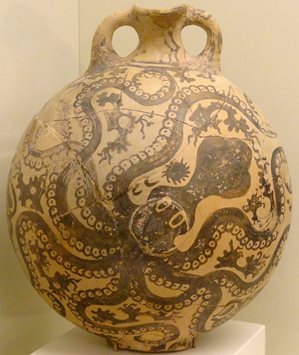c. 1450 BC
Minoan Pottery Sherd
Decorated in the Marine Style and dating to circa 1450 BC.
By Leo McNameeDescription
The original museum register entry for this sherd of pottery reads: “1912:217 Palace –Knossus, 3x2½, black tentacle? and seaweed.” It was acquired by the museum from University College Dublin Museum courtesy of Professor Henry Brown, who was Professor of Greek at UCD from 1902 -1922. As the attached label indicates it was excavated from the palace of Knossos by the famous archaeologist Arthur Evans - “Palace-Knossus, excavated by Arthur Evans D.Litt., 1900-1905”.
This small fragment of decorated pottery is an example of Marine Style pottery found on Crete during the Late Minoan IB period, circa 1450BC. The fabric is a pink-buff clay with the decoration applied using a black / brown paint. The decoration consists of part of an octopus tentacle with suckers, some seaweed and rockwork. It is not clear what type of pot this fragment comes from and at least 13 different pot shapes have been found decorated in the Marine Style. However, the octopus motif is most often found on stirrup-jars and pear-rhyta which are a type of drinking vessel used for pouring liquids during libations.

The Marine Style
It is useful to compare this sherd to a complete Marine Style vase such as this example from the Heraklion Archaeological Museum. It has been suggested that fewer than four artists were at work in the decoration of Marine Style vases during the Late Minoan IB period. A particular stylization is used for each element, so that one motif may appear in exactly the same way on a number of different vases. Here, the artist has wonderfully represented an octopus on a stirrup-jar and the sense of movement and life is impressive. The head of the creature is placed at the widest part of the vase where it can be displayed to the best advantage. The animal is shown as a flat silhouette with the head placed diagonally and the tentacles floating around it. The eight tentacles are informally arranged around the creature and some of them overlap one another. The suckers, carefully painted at the sides of the tentacles, help give the animal added interest. Importantly, the tentacles take up the space on the sides of the vase where the distortion caused by the curvature of the surface does not interfere with the image. The distortion as the vase is held in the hands and turned might even be an advantage if it helps to suggest the movement of the creature in water.
Function
Although Marine Style pottery can be found in secular contexts, the large number of examples found in ritual contexts suggests that some Marine Style vases should be considered as part of cult equipment. For example, excavations from the Stratigraphical Museum extension at Knossos uncovered the remains of butchered children believed to have been ritually sacrificed. A conical rhyton decorated with an octopus was among the cult equipment found with these bodies. Pottery vessels with pierced bases, such as rhyta, are known to have been used in ritual libations. The numerous pottery types and shapes decorated in the Marine Style suggest that not all of this pottery was produced for ritual use. These different shapes could also appear portraying other Late Minoan motifs and be found
in ordinary household contexts.
Cretan Art
Many cult vessels decorated in the Marine Style were produced in workshops at Knossos and then exported around Crete. Elaborate Marine Style pottery from the Late Minoan period also reached mainland Greece and the islands where they were later imitated; however, the traditional Cretan motifs began to lose their life and movement when they were copied on the mainland. The essential quality of Cretan art, and the one that distinguishes it from the contemporary art of Egypt and Mesopotamia, is the power to suggest movement such as the octopus here does.
Learn more
This item is not on display and is part of the museum’s Reserve Collections. The Minoans traded and shared ideas with the Ancient Egyptians and you can view pottery from this period in the exhibition ‘Ancient Egypt’ at the National Museum of Ireland - Archaeology on Kildare Street.
References
P.P. Betancourt, 2007. Introduction to Aegean Art. Philadelphia, INSTAP
P.P. Betancourt, 1973. The Polyp Workshop: A Stylistic Group from LM IB. AJA 77:3. p. 333-334. [JSTOR]
M.S.F. Hood, 1978. The Arts in Prehistoric Greece. Harmondsworth: Penguin
P. A. Mountjoy, 1985. Ritual Associations for LM IB Marine Style Vases, in P. Darcque and J-C. Poursat (eds.), L'iconographie minoenne BCH Supplement 11. Athens/Paris, 231-242.
Location:
Minoan Pottery Sherd is located at:
In Storage
Previous artefact:
Medieval Painted Glass from St Canice’s Cathedral, Co. Kilkenny
Next artefact:
Miss Gwendoline Clare Stacpoole: An Unsung Heroine of Irish Archaeology
